
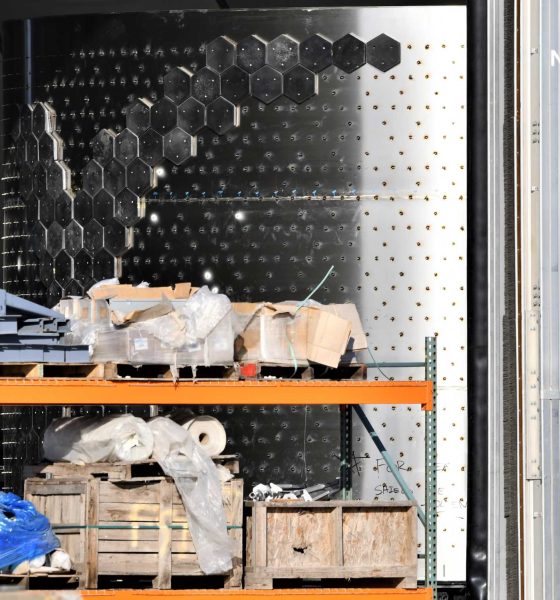
News
SpaceX installs orbital Starship heat shield prototype with robots
SpaceX has begun large-scale Starship heat shield installation tests with the help of robots delivered last month in a sign that the company has already begun preparing for the rocket’s first orbital flight test campaign.
Designed to eventually replace SpaceX’s workhorse Falcon 9 and Falcon Heavy launch vehicles, Starship is a fully-reusable two-stage rocket powered by methane and oxygen-fueled Raptor engines. Just like Falcon 9, Starship’s first stage (known as Super Heavy) will launch the combined spacecraft and upper stage to an altitude of 70 to 100 km (40-65 mi) and velocity of ~2.5 to 3 kilometers per second (1.5-1.9 mi/s). Super Heavy will separate, boost back towards land, and either land back at the launch pad or on a floating platform.
SpaceX already has extensive experience launching, landing, and reusing orbital-class rocket boosters thanks to Falcon 9 and Heavy, which have completed 57 landings and been reused 39 times in less than five years. The Starship upper stage, however, will have to survive orbital-velocity atmospheric reentries some 3 to 5 times faster and exponentially more energetic than Super Heavy boosters. To do so routinely while keeping Starship cost and complexity low and reusability high, SpaceX will have to develop an unprecedentedly effective heat shield that is easier to install, maintain, and reuse than anything that has come before it.
As with all SpaceX programs, the company began Starship heat shield installation development as soon as possible, installing a handful of tiles (presumably early-stage prototypes) on Starhopper as far back as H1 2019. This continued with small hexagonal tile installation tests on Starships SN1, SN3, SN4, SN5, and SN6 throughout 2020. While those coupon tests obviously didn’t involve orbital-class reentry heating or buffeting, they were still useful to characterize the mechanical behavior of heat shield tiles under the stress of cryogenic propellant loading, Raptor static fires, and hop tests.
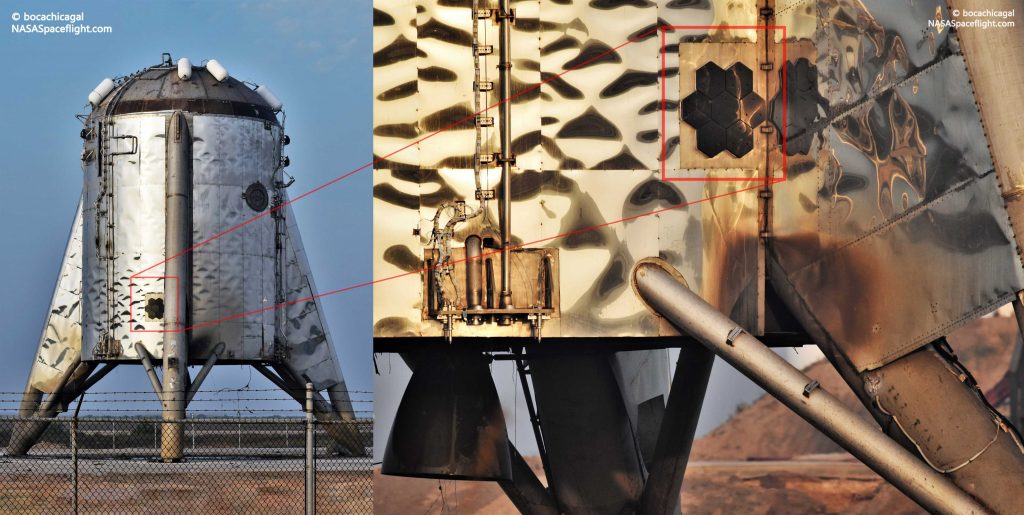
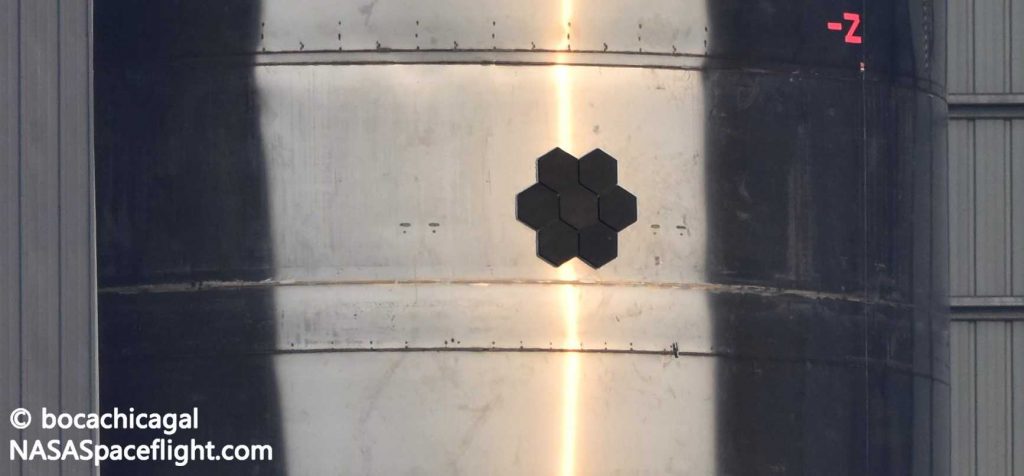
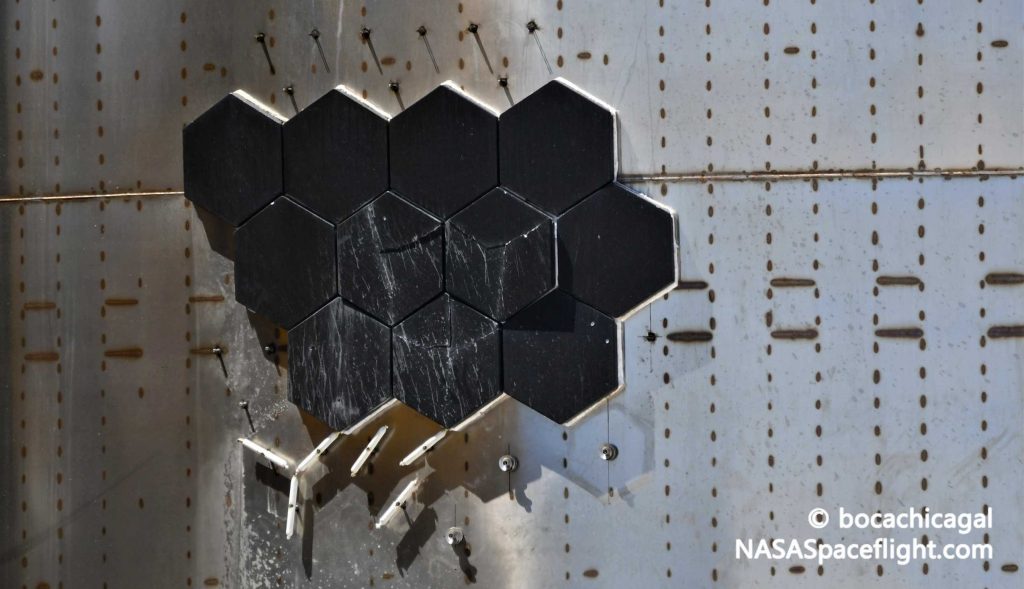
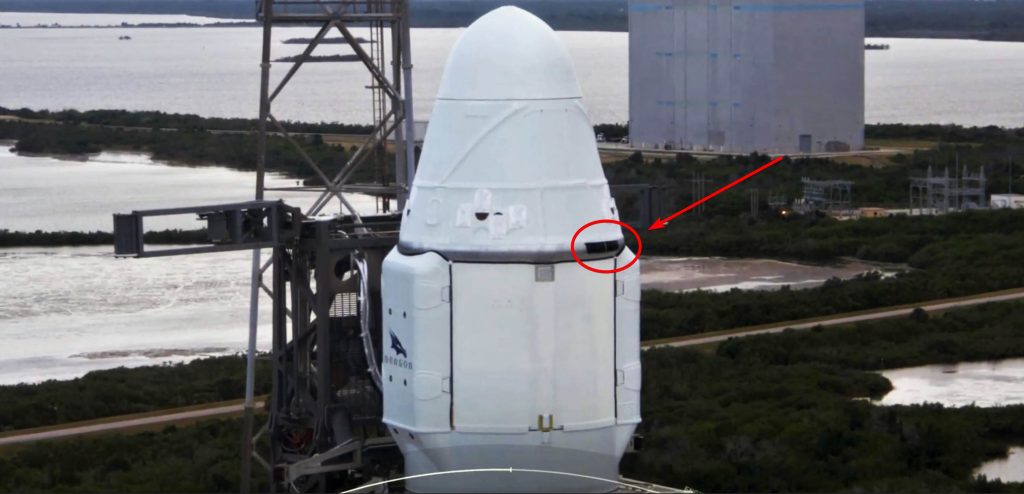
In 2019, SpaceX even tested a few ceramic Starship heat shield tiles on an orbital Cargo Dragon mission for NASA. The fact that no more orbital Cargo or Crew Dragon tests were acknowledged seems to suggest that the demonstration was a success, proving that the tiles can stand up to the stresses of reentry from low Earth orbit (LEO).
Behind the scenes, SpaceX is assuredly performing extensive laboratory-style tests with tiles and an agreement signed with NASA Ames Research Center confirmed that the company is using the facility’s arcjet to physically simulate the conditions of orbital-velocity reentry. Tests on the scale of a full Starship, however, are an entirely different story.
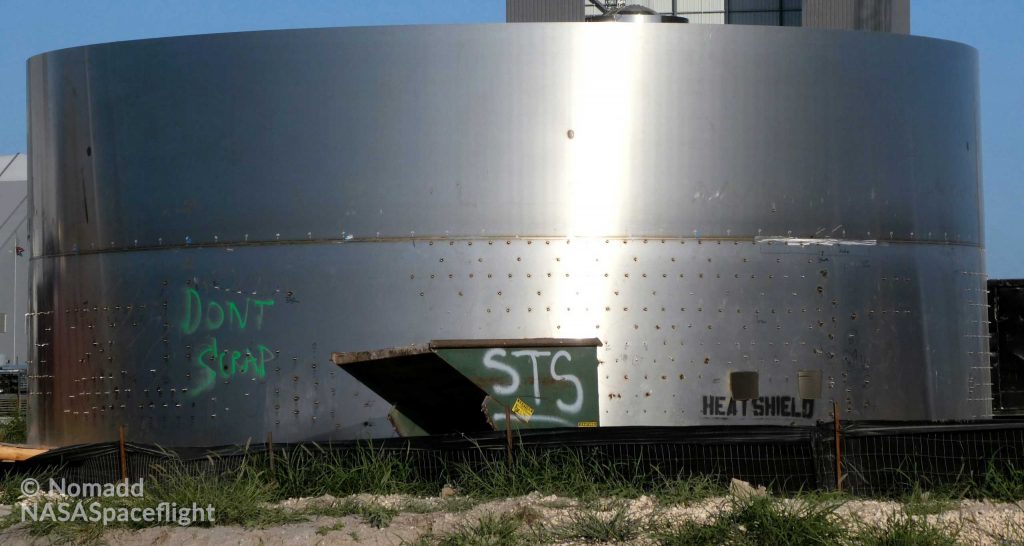
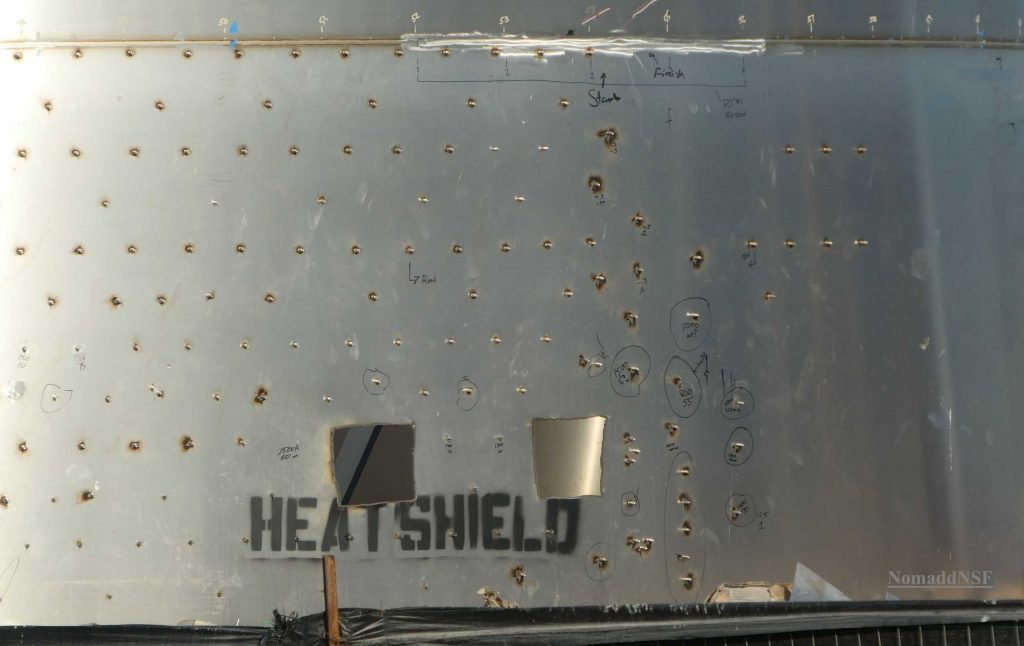
The first signs of large-scale heat shield installation testing appeared on July 9th when local resident and photographer Andrew Goetsch (Nomadd) captured photos of a test coupon covering half of an entire steel Starship ring. In April 2020, CEO Elon Musk confirmed on Twitter that the current design involved affixed heat shield tiles directly to Starship’s steel hull with steel studs. It’s unclear how exactly the company is installing steel studs directly onto the ~4mm (0.15 in) thick skins of a pressure vessel or if an off -the-shelf solution was available but Nomadd’s July 9th photos explicitly show the process required to refine the settings on the mystery stud installer.
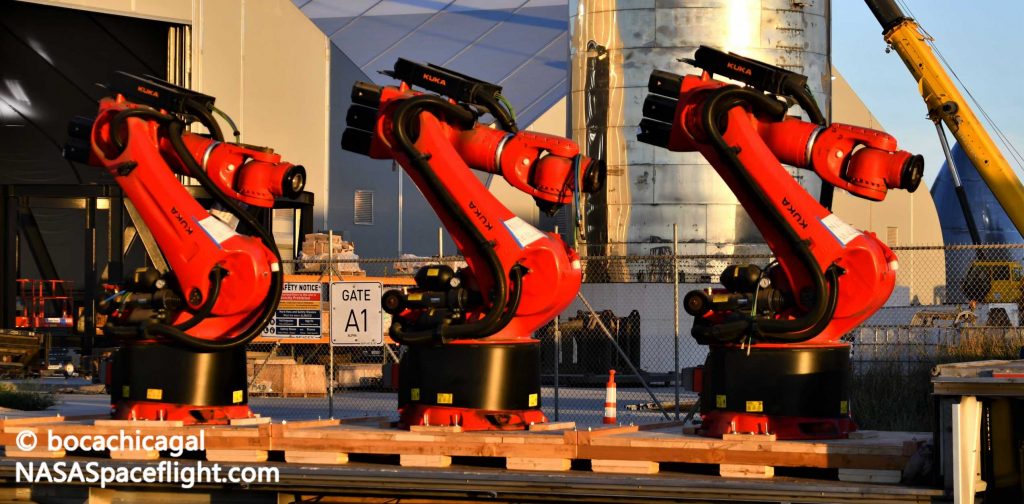
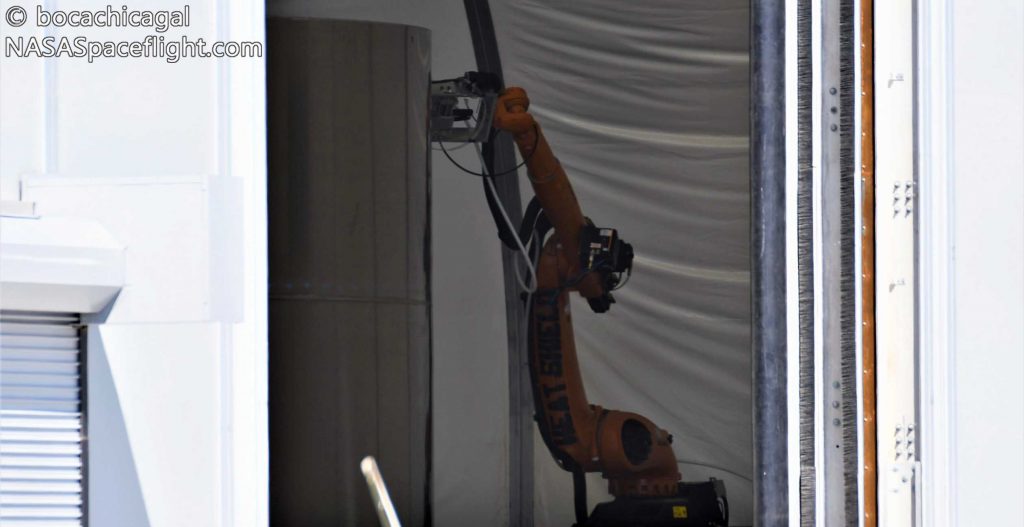
One month after Nomadd’s spotting, three weeks after a robot delivery, and five days after one of those robots – labeled “HEAT SHIELD – was spotted in action, the first large-scale heat shield installation test article was spotted inside one of SpaceX’s several production tents. The team involved clearly had some fun with the process, installing the tiles in the form of a SpaceX “X”.
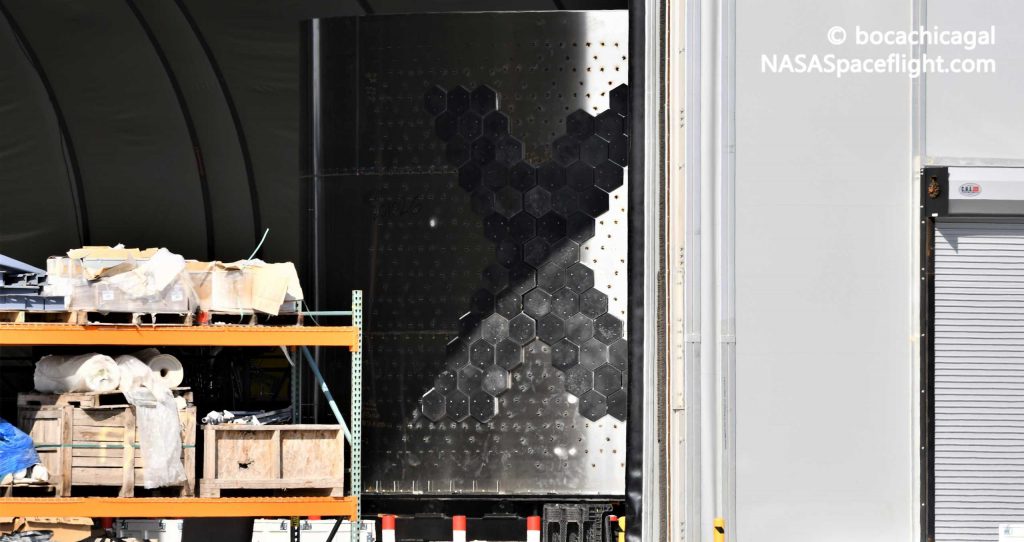
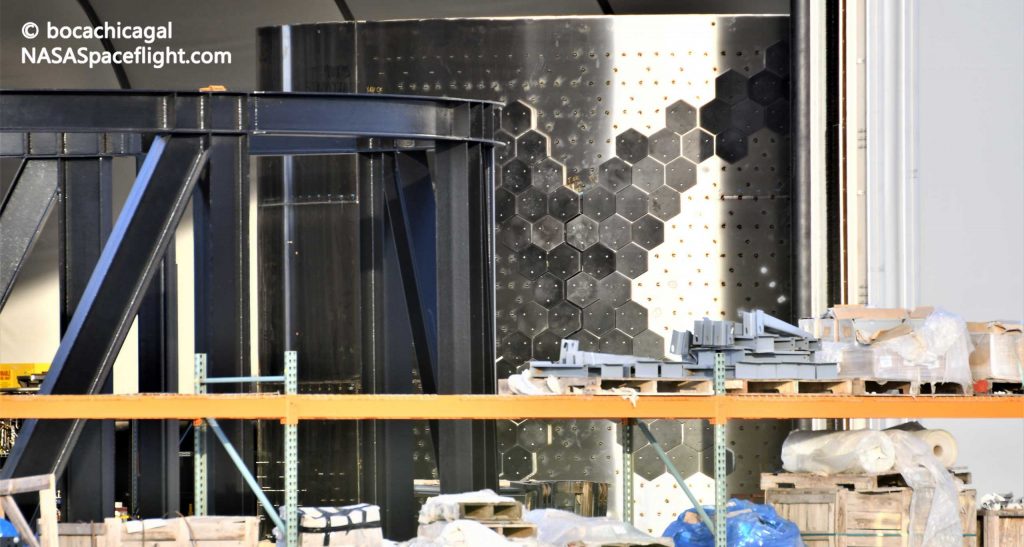
In retrospect, robots could be a perfect solution for the affordable, high-volume installation of the thousands of heat shield tiles a single Starship will need. Once tolerances are high enough, it’s conceivable that multiple different Starship sections could be individually outfitted with studs and heat shield tiles by robot, inspected by humans, and joined together to form a complete Starship. Humans would likely need to manually install a gap of tiles around the weld lines of those final sections, but the manual installation work would be reduced to a minimum while keeping the required infrastructure dead simple.
Ultimately, a great deal of work remains before SpaceX can even begin to feasibly attempt orbital Starship test flights, but it’s hard not to get excited by the fact that some of that preparatory work has already visibly begun in South Texas.
Check out Teslarati’s Marketplace! We offer Tesla accessories, including for the Tesla Cybertruck and Tesla Model 3.

News
Tesla hosts Rome Mayor for first Italian FSD Supervised road demo
The event marked the first time an Italian mayor tested the advanced driver-assistance system in person in Rome’s urban streets.
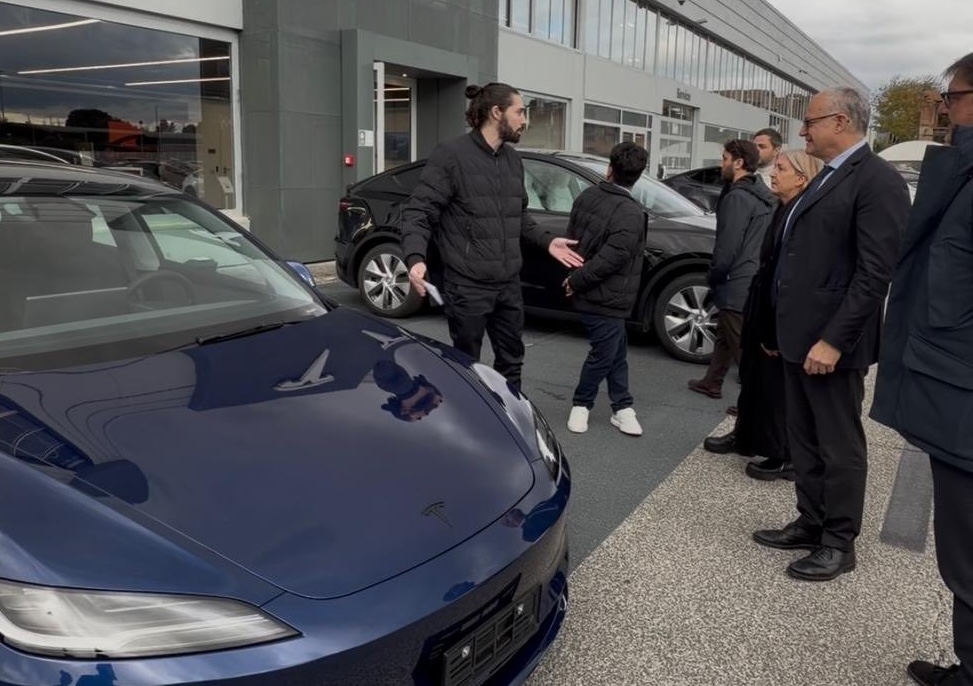
Tesla definitely seems to be actively engaging European officials on FSD’s capabilities, with the company hosting Rome Mayor Roberto Gualtieri and Mobility Assessor Eugenio Patanè for a hands-on road demonstration.
The event marked the first time an Italian mayor tested the advanced driver-assistance system in person in Rome’s urban streets. This comes amid Tesla’s push for FSD’s EU regulatory approvals in the coming year.
Rome officials experience FSD Supervised
Tesla conducted the demo using a Model 3 equipped with Full Self-Driving (Supervised), tackling typical Roman traffic including complex intersections, roundabouts, pedestrian crossings and mixed users like cars, bikes and scooters.
The system showcased AI-based assisted driving, prioritizing safety while maintaining flow. FSD also handled overtakes and lane decisions, though with constant driver supervision.
Investor Andrea Stroppa detailed the event on X, noting the system’s potential to reduce severe collision risks by up to seven times compared to traditional driving, based on Tesla’s data from billions of global fleet miles. The session highlighted FSD’s role as an assistance tool in its Supervised form, not a replacement, with the driver fully responsible at all times.
Path to European rollout
Tesla has logged over 1 million kilometers of testing across 17 European countries, including Italy, to refine FSD for local conditions. The fact that Rome officials personally tested FSD Supervised bodes well for the program’s approval, as it suggests that key individuals are closely watching Tesla’s efforts and innovations.
Assessor Patanè also highlighted the administration’s interest in technologies that boost road safety and urban travel quality, viewing them as aids for both private and public transport while respecting rules.
Replies on X urged involving Italy’s Transport Ministry to speed approvals, with one user noting, “Great idea to involve the mayor! It would be necessary to involve components of the Ministry of Transport and the government as soon as possible: it’s they who can accelerate the approval of FSD in Italy.”
News
Tesla FSD (Supervised) blows away French journalist after test ride
Cadot described FSD as “mind-blowing,” both for the safety of the vehicle’s driving and the “humanity” of its driving behaviors.
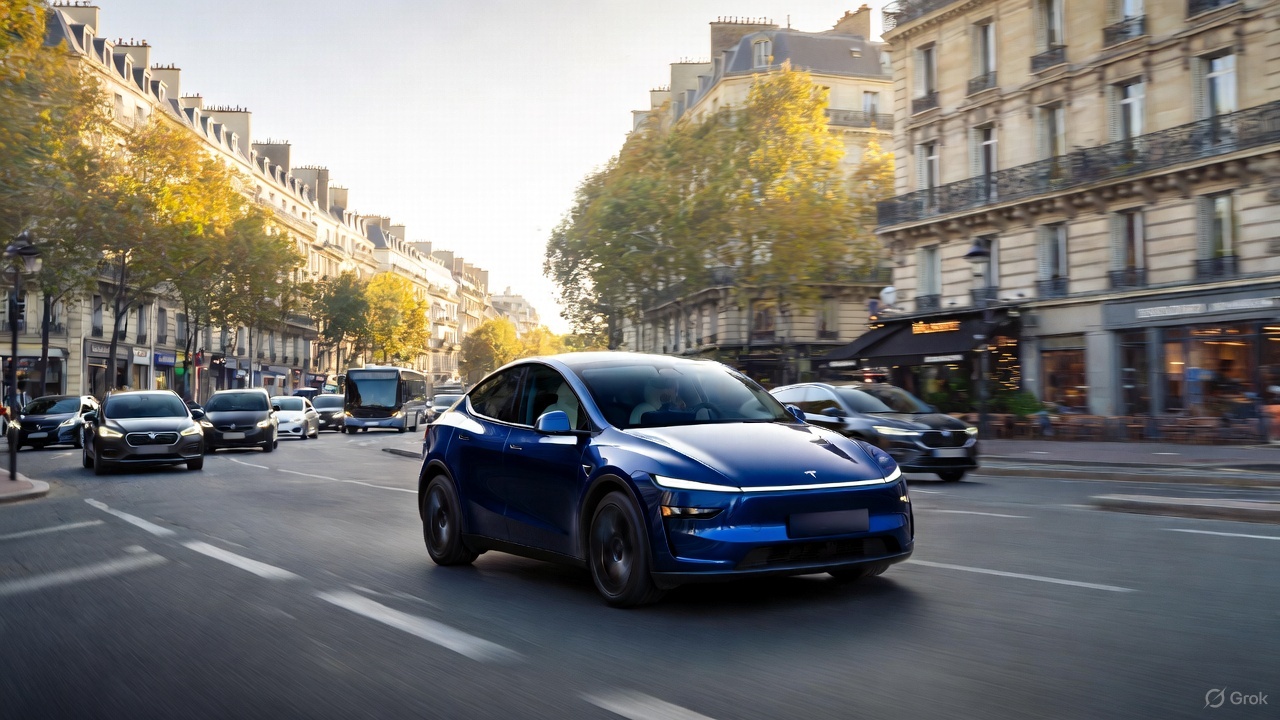
Tesla’s Full Self-Driving (Supervised) seems to be making waves in Europe, with French tech journalist Julien Cadot recently sharing a positive first-hand experience from a supervised test drive in France.
Cadot, who tested the system for Numerama after eight years of anticipation since early Autopilot trials, described FSD as “mind-blowing,” both for the safety of the vehicle’s driving and the “humanity” of its driving behaviors.
Julien Cadot’s FSD test in France
Cadot announced his upcoming test on X, writing in French: “I’m going to test Tesla’s FSD for Numerama in France. 8 years I’ve been waiting to relive the sensations of our very first contact with the unbridled Autopilot of the 2016s.” He followed up shortly after with an initial reaction, writing: “I don’t want to spoil too much because as media we were allowed to film everything and I have a huge video coming… But: it’s mind-blowing! Both for safety and for the ‘humanity’ of the choices.”
His later posts detailed FSD’s specific maneuvers that he found particularly compelling. These include the vehicle safely overtaking a delivery truck by inches, something Cadot said he personally would avoid to protect his rims, but FSD handled flawlessly. He also praised FSD’s cyclist overtakes, as the system always maintained the required 1.5-meter distance by encroaching on the opposite lane when clear. Ultimately, Cadot noted FSD’s decision-making prioritized safety and advancement, which is pretty remarkable.
FSD’s ‘human’ edge over Autopilot
When asked if FSD felt light-years ahead of standard Autopilot, Cadot replied: “It’s incomparable, it’s not the same language.” He elaborated on scenarios like bypassing a parked delivery truck across a solid white line, where FSD assessed safety and proceeded just as a human driver might, rather than halting indefinitely. This “humanity” impressed Cadot the most, as it allowed FSD to fluidly navigate real-world chaos like urban Paris traffic.
Tesla is currently hard at work pushing for the rollout of FSD to several European countries. Recent reports have revealed that Tesla has received approval to operate 19 FSD test vehicles on Spain’s roads, though this number could increase as the program develops. As per the Dirección General de Tráfico (DGT), Tesla would be able to operate its FSD fleet on any national route across Spain. Recent job openings also hint at Tesla starting FSD tests in Austria. Apart from this, the company is also holding FSD demonstrations in Germany, France, and Italy.
Elon Musk
Tesla Optimus shows off its newest capability as progress accelerates

Tesla Optimus showed off its newest capability as progress on the project continues to accelerate toward an ultimate goal of mass production in the coming years.
Tesla is still developing Optimus and preparing for the first stages of mass production, where units would be sold and shipped to customers. CEO Elon Musk has always marketed the humanoid robot as the biggest product in history, even outside of Tesla, but of all time.
He believes it will eliminate the need to manually perform monotonous tasks, like cleaning, mowing the lawn, and folding laundry.
However, lately, Musk has revealed even bigger plans for Optimus, including the ability to relieve humans of work entirely within the next 20 years.
JUST IN: Elon Musk says working will be ‘optional’ in less than 20 years because of AI and robotics. pic.twitter.com/l3S5kl5HBB
— Watcher.Guru (@WatcherGuru) November 30, 2025
Development at Tesla’s Artificial Intelligence and Robotics teams has progressed, and a new video was shown of the robot taking a light jog with what appeared to be some pretty natural form:
Just set a new PR in the lab pic.twitter.com/8kJ2om7uV7
— Tesla Optimus (@Tesla_Optimus) December 2, 2025
Optimus has also made several public appearances lately, including one at the Neural Information Processing Systems, or NeurIPS Conference. Some spectators shared videos of Optimus’s charging rig, as well as its movements and capabilities, most interestingly, the hand:
You have to hand it to Elon 🤟 pic.twitter.com/fZKDlmGAbe
— Ric Burton · NeurIPS 2025 (@_ricburton) December 2, 2025
The hand, forearm, and fingers have been one of the most evident challenges for Tesla in recent times, especially as it continues to work on its 3rd Generation iteration of Optimus.
Musk said during the Q3 Earnings Call:
“I don’t want to downplay the difficulty, but it’s an incredibly difficult thing, especially to create a hand that is as dexterous and capable as the human hand, which is incredible. The human hand is an incredible thing. The more you study the human hand, the more incredible you realize it is, and why you need four fingers and a thumb, why the fingers have certain degrees of freedom, why the various muscles are of different strengths, and fingers are of different lengths. It turns out that those are all there for a reason.”
The interesting part of the Optimus program so far is the fact that Tesla has made a lot of progress with other portions of the project, like movement, for example, which appears to have come a long way.
However, without a functional hand and fingers, Optimus could be rendered relatively useless, so it is evident that it has to figure this crucial part out first.








